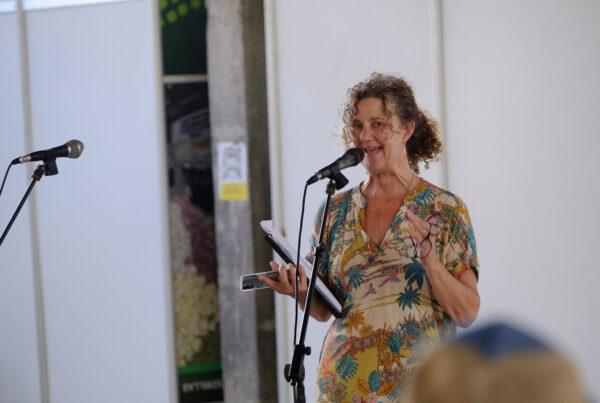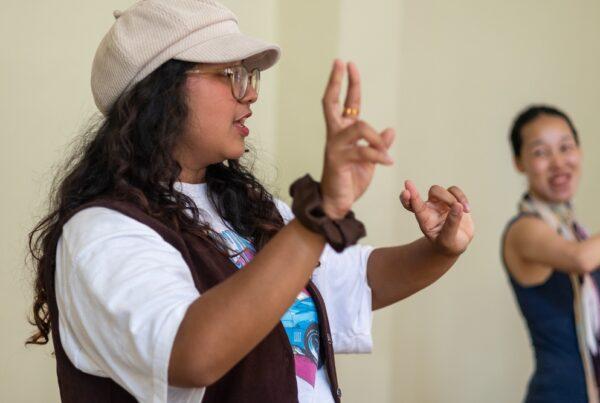I meet Dalija Acin Thelander at the Children’s Cultural Centre in the heart of Novi Sad where she has just concluded her 3-day workshop that aims to provide the most relevant and progressive theoretical and practical knowledge in creating performances for babies and children with disabilities.
I’m intrigued. Not because it’s an invitation only event, neither because it’s totally out of my league, I’m a writer and not a performance practitioner. But because back in Cyprus, where I currently live, there are no performances for babies. Never mind children with disabilities. To this end I’m most probably the least reliable person to judge what performing for babies and children entails. But in essence I understand that including them in the realms of Theatre for Young audiences is their right. Why not?
From a teaching perspective, Dalija intended for her workshop to inspire and encourage artistic creation, further enabling attendees to experience and explore a sensorial-perceptual approach to performance-making, including an examination of the creative processes of designing music, staging, costumes, and props. “By creating a space for dialogue, knowledge sharing, critical perspectives and experimentation, the workshop empowers participants to embark on a new creative journey, disseminating good practice and advocating for the importance of the artistic experience for babies and children with disabilities,” described the workshop’s blurb.

Dalija Acin Thelander
Yet as I get to know Dalija in person, I’m drawn to what actually instigated her desire to work with babies and children with disabilities.
“I have a career as a contemporary dance choreographer working mostly with postmodern minimalistic trends back in Belgrade, and in my artistic work I was always looking for things that were challenging,” Dalija tells me with a confidence that’s endearing.
With a formal education of 8 years of ‘ballet school Russian style’ as she puts it, everything Dalija has done has come through self-education and self-organisation.
“Everything I learned, I learnt by doing, so that’s why I was always putting challenges on myself and working with performers that were not regular performers, exploring myself, exploring with choreographers and expanding my practice,” she tells me.
Having reached the peek of her career as she was making performances that were delegated to the audiences, there came a time when she decided to abandon adult audiences for ideological reasons and her belief that she had to have an urgency in what she was doing.
“I was doing really extended practice. I was making performances that were delegated to the audience, I was not interested anymore in sacralised artists or controlling the environment or anything like that. I was making immersive works and what made sense for the audience, what makes sense for them on their terms,” reveals Dalija.
Moving to Sweden in 2012 seems to be a turning point in Dalija’s path. “I was asked to do my first performance for babies in Belgrade… and I was surprised when I was proposed to do this because I was doing this obscure minimalistic work… I didn’t know how to make performances for babies but I took it as a challenge. I had no knowhow, only intuition and looking back, it’s actually the ground practice that I established there that I still use up until today,” explains Dalija.
Once in Sweden Dalija dedicate her time entirely to performing for babies. “It made sense for me, as I reflected on different contexts and remembering how strong the experience of actually performing for babies was, I was falling in love with that way of perception, complete inhibition, and beautiful minds in their the way of consciousness, their way of being present,” reveals Dalija.
Eventually Dalija combined her practice with theory, she read developmental studies and all sorts of research to understand what kinds of minds, bodies, perceptions she was working with. “It was immensely empowering. And definitely, it made me understand more and more about how much of the work that is produced for babies is produced from an out-dated perspective,” she adds.
“Understanding that perception and seeing that there is much missing in the context from the perspective of progressive artistic thinking, I wanted to explore aesthetics, explore materials, explore the practices that are most meaningful for me, and from the perspective of seeing performance events as an ecology, rather than a static environment full of control and very unequal (between performer and audience),” says Dalija.
Her introduction to working with children with disabilities followed all the work that she had accomplished. “I had done all this stuff, I was sharing my knowledge and I was influencing the international scene, I built a vocabulary or the practice, connected it with the theory, but I needed to learn more, I needed more challenges,” she says.
Its with this urge that she was asked to look into what was happening with regards to performances with children in the northern hemisphere of the world. “I realised that there wasn’t much happening, at least not progressive approaches,” reveals Dalija.
And this is how she decided that she wanted to contribute to this specific field as well. “Practices for babies and children with disabilities are very similar… The biggest concern that conventional theatre has with such audiences, is that they don’t behave, they need to move, they need to voice; they go for what they need and how they need it, on their own terms. I was already working on immersive environments so I had no problems in my own practice when facing audiences who wanted things on their own terms. I was already empowering the audience, I wanted to see what else there was to learn,” affirm Dalija.
Eventually Dalija went more into the discourse and the theoretical aspect of working with children with disabilities and got funding from the Swedish Research Council to do an academic research.
But reverting back to what it’s actually like to work on the ground and face-to-face with babies and children with disabilities, Dalija is quick to pinpoint the uniqueness. “On the ground, as a sense of encounter with your audience, it’s amazing. It’s amazing to see the power of the potential of movement and how immense it is. I’m really happy that I work with choreography and dance and I don’t come from a drama background.”
And so nowadays, Dalija performs in hospitals, special schools and in public spaces and she also teacher her practice.
Coming to a close to our conversation it’s clear that Dalija has mastered her art. It’s also clear that she won’t be able to pursue her work without having some kind of new challenge to overcome. To this end she’s in the unknown. Her next steps are undefined. Perhaps it will be more about advocating for less segregation of audiences in the larger performing arts context and have dance performances for children on the programmes of big mainstream dance festivals which are only or mostly for adult audience so far. Perhaps it will be to sit back and look at the groundwork that she has laid. Or maybe she’ll surprise us with something entirely new. Who knows?
For mote information on Dalija’s work click here.

Melissa Hekkers is a freelance journalist and author.
Her most recent book, Amir’s Blue Elephant, a creative non-fiction based on her experiences working in the Moria refugee camp in Lesvos, Greece and Cyprus. In 2018, she launched the My Cyprus Mandala Series, colouring books inspired by the natural and cultural heritage of Cyprus. In 2007, she published her first children’s book in both English and Greek entitled Crocodile, which won the Cyprus State Illustration Award. In 2012, she launched her second children’s book Flying across Red Skies (in English and Greek), using an experimental approach to literature, for which she was nominated for the Cyprus State Literary award. Her third, similarly well-received children’s book was Pupa (Greek and English), published in 2014 and was adapted as a theatre play in 2019. In between her last two books, she published her first free-verse poetry book entitled Come-forth. In 2019 she was contributing author to the anthology Nicosia Beyond Barriers: Voices from a Divided City, published by Saqi Books, London.





